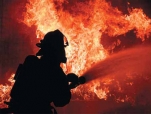Fire Load and Severity of Fires

1 Fire Lo ad Survey Data
Fire loads historically have been established by surveys of typical buildings in various use categories. Live loads used in structural engineering design were established in the identical manner. The relationship between fuel load and fire severity was established by Ingberg in 1928. To achieve this goal, several survey programs were conducted to establish data for representative use categories of buildings. The National Bureau of Standards (NBS) published fuel-load surveys of residential buildings and office buildings. A very detailed study was carried out in Switzerland in 1967–1969 for the Swiss Fire Prevention Association for Industry and Trade.
The duration of the fire was referred to as the fire severity (in hours) and represented the time needed to consume most of the fuel in the compartment. The effects of ventilation, the form of the fuel, and heat losses to boundaries were not taken into account. Ingberg had considered the worst possible condition of a fire scenario: no suppression, meaning that all the combustibles in the compartment should be consumed without causing failure of any structural element. The second very important finding by Ingberg was the ability to compare and equate the severity of two fires (the so-called t-equivalence method). As described by Law, “The term t-equivalent is usually taken to be the exposure time in the standard fire resistance test which gives the same heating effect on a structure as a given compartment fire.” The duration and severity of a real fire are not defined well as the standard fire test curve. The time-equivalence concept makes use of fire-load and ventilation data in a real compartment fire to produce a value that would be “equivalent” to the exposure time in the standard test (for a detailed explanation and application in a structural fire load design case, see below). Formulating equivalent fire exposures traditionally has been achieved by gathering data from roomburn experiments where protected steel temperatures were recorded and variables relating to the fire severity were changed systematically (e.g., ventilation, fire load, and compartment shape).
The fuel load data were provided by NBS (now the National Institute of Standards and Technology [NIST]) fuel-load surveys con- ducted in residences, offices, schools, hospitals, and warehouses. Because the expected fire severity is one of the bases for the fire- resistance requirements of structures, knowledge of it is essential. At present, predictions of fire severities can be made as a function of the amount of combustible material present in the room, the size and geometry of the room, the dimensions of the ventilation available, the heat losses through the openings, the emissivity of the flames in the room, and the thermal properties of the room surfaces. However, in predicting fire performance, two critical parameters - the fire load and the opening factor of the room - must be known.
Besides the ventilation characteristics, fire load is the starting point for estimating the potential size and severity of a fire. Previous surveys have measured only mass and calorific value of the fuel load. However, at present, a need has been identified for fuel-load data that also include the exposed surface area of the fuel items so that the rate and duration of fuel-controlled burning can be better assessed. The intensity and duration of fire in different building occupancies vary greatly depending on the amount and surface area of the combustible material present, as well as the characteristics of the available ventilation. Therefore, an accurate prediction of the possible fire load in a certain building occupancy will assist the engineer in better estimating the likely fire severity and thus help to provide adequate and cost-effective fire protection.
Full version you can download here
 Text by LEO Razdolsky, LR Structural Engineering Inc., Lincolnshire, Illinois, USA, Professor at Northwestern University, Evanston, Illinois, USA
Text by LEO Razdolsky, LR Structural Engineering Inc., Lincolnshire, Illinois, USA, Professor at Northwestern University, Evanston, Illinois, USA


